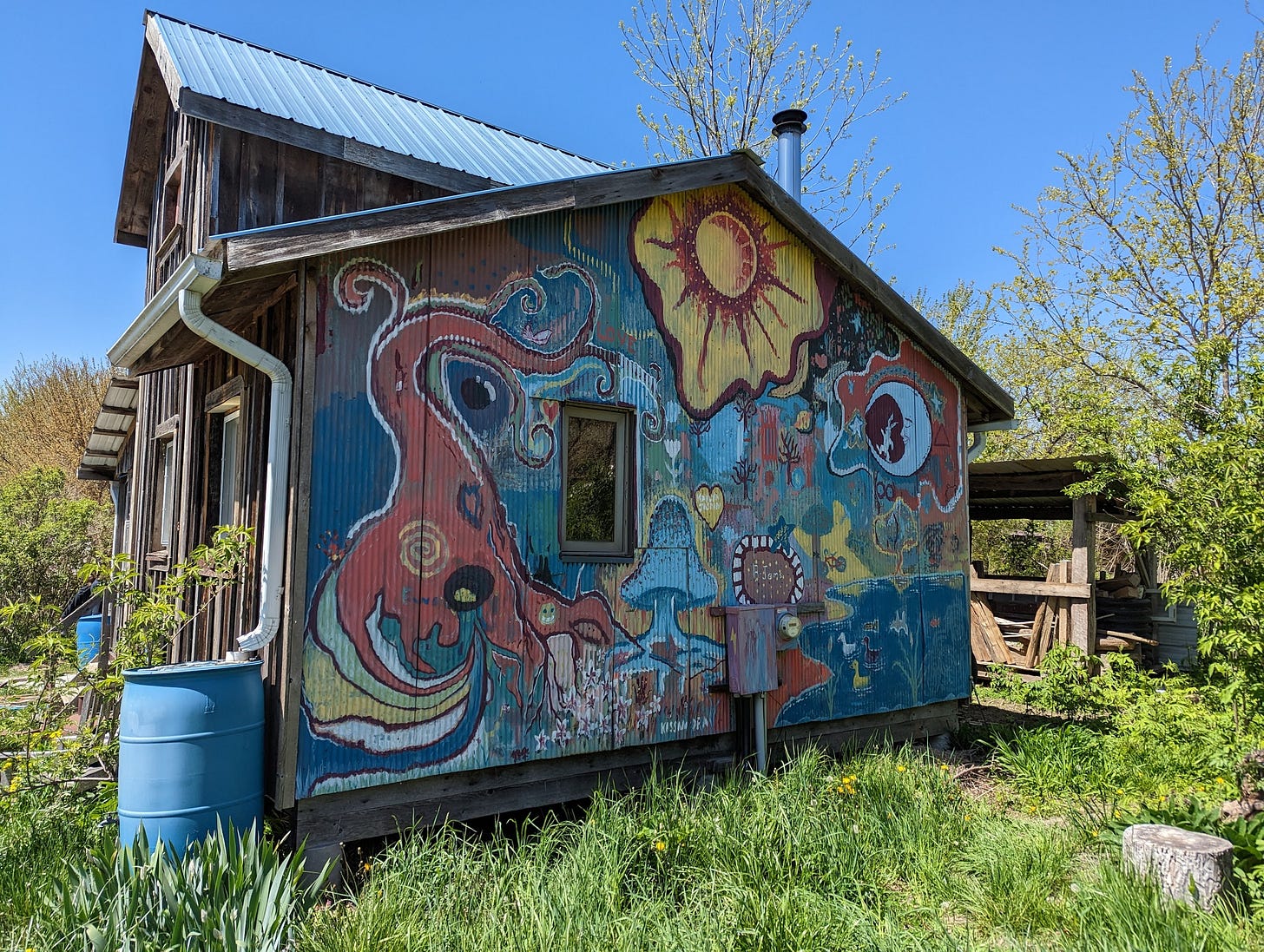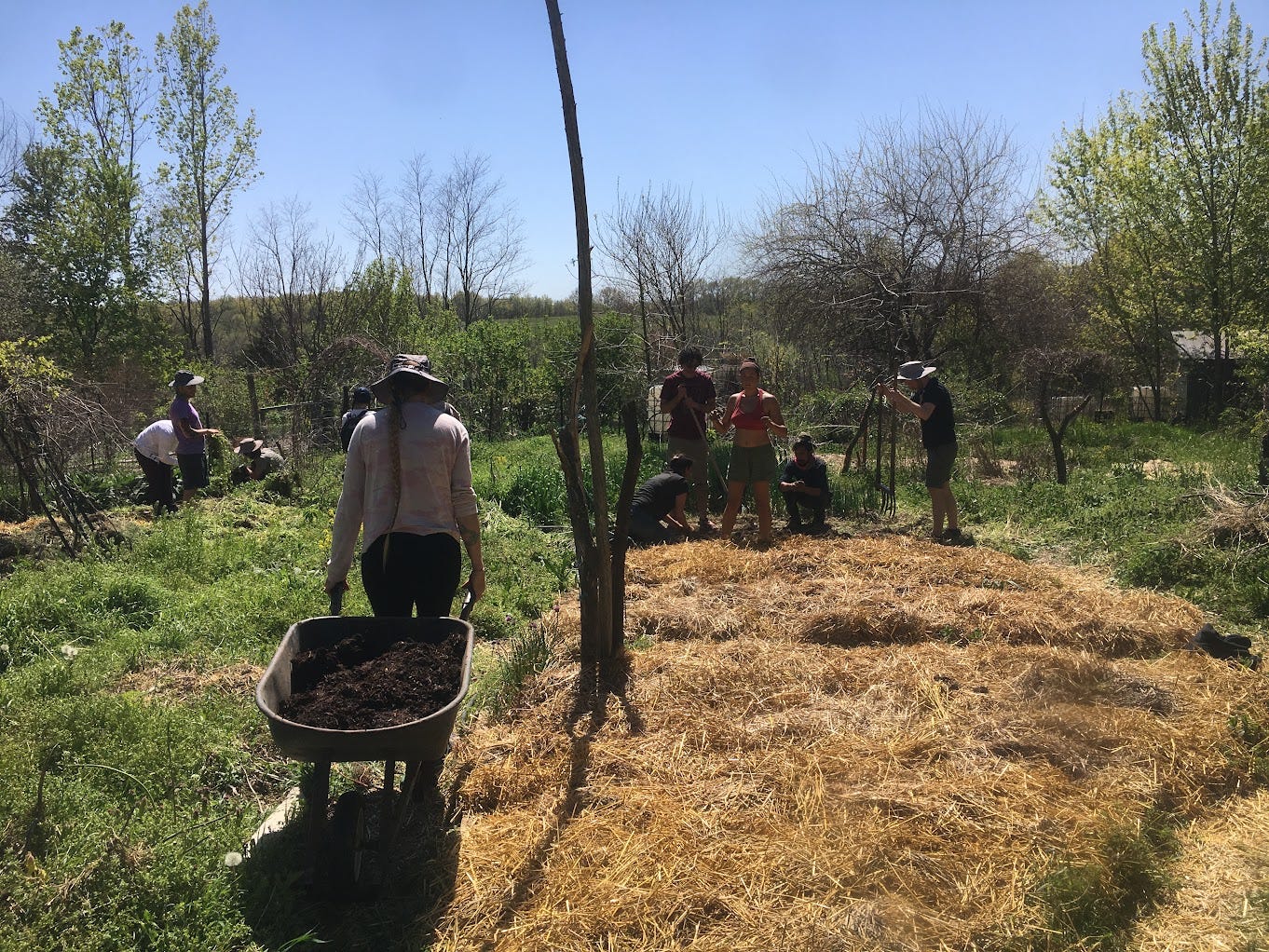We're building a new world, all of my friends and me
It's not an exact science yet, but we have the technology
Community is the technology.
Let me explain…
A few weeks ago, I spent 12 days at Dancing Rabbit Eco-Village. Concurrently, I was part of a 6-week Climate Solutions Course with Soapbox Project. Both experiences put me in community with like-minded people who cared deeply about helping the earth.
At Dancing Rabbit, we had a discussion about the limits of the traditional environmental movement which thinks of humans as separate from nature.
Through this lens, I looked at the “green” efforts at a local rock climbing gym — a water fountain that tells you how many plastic bottles are saved, a café with an indoor tree — and thought to myself how small and seemingly futile these things were.
I wanted the world to be an eco-utopia — a world like Dancing Rabbit or The Biggest Little Farm. I was dismayed that it wasn’t. I saw how far we had to go and just didn’t see a way to get there.
A week ago, I “came out” with my despair to my Soapbox Group.
“Doing micro-actions — like getting a composting bin — seems so small and useless compared to the magnitude of what needs to be done,” I said.
Nivi, the course leader, stayed on the call with me for a while after the class was over. She didn’t try to change what I was feeling. She just listened.
I sat with my despair for a few days. Then, on a whim, I bought a book by Mark Manson, and read an intriguing paragraph where Manson claimed that there are three things we can’t change: other people, the past, and the world.
The first two, I could get behind. But wait a minute…wasn’t changing the world what activism was all about? If people thought they couldn’t change the world, then we’d never progress. You can’t be right, Mark, I thought.
But the more I reflected, the more I realized that Manson is kind of right.
Take the example of Dancing Rabbit. This is a place with hundreds of acres of land, dozens of beautiful and unique buildings. No one person could build such a place. It took hundreds of people and 25 years to make Dancing Rabbit what it is today.
We are sold narratives of rugged individualism, of the Jobses and the Musks and the Gateses doing big things on their own. But in reality, changes in the world are made not by individuals, but by communities.
Behind every famous person, there are many others, working to further the mission. It took a million people to march on Washington in support of Martin Luther King Jr.’s dream. And the work of racial justice is not over. A devoted community of millions continues the work.
I realized that the unit of social change is not the individual, but the community. This realization has taken a burden off my shoulders. It has let me be more compassionate with myself about my individual “failings.” No amount of green actions on my part can change the world. Finding a like-minded community, or communities, to work alongside, is where it’s at.
Today, our Soapbox group had our final meeting. As I reflected on my despair a week ago, another realization dawned on me:
I can’t ultimately control what happens to the planet, but I can choose to show up and work on solutions with like-minded people who care.
I felt lighter.
In the words of Mark Manson, I realized that I had been giving f*cks to things I can’t control: what happens to the world. It would be far better to give my f*cks to what I can control: my actions and how I think about things.
That’s a big reason why I’m writing here. I want to clarify my thinking.
I think of our planet as a boat with a leak.
Despair is looking at the leak and thinking: "We'll never plug it up in time. Any action is too little, too late. We’re doomed, so there’s no point in doing anything."
Despair is passive. When I’m in despair, I’m watching the boat sink. Feeling bad and doing nothing, like the guy in this picture:
Purpose, on the other hand, is active. I think of purpose as a community of people showing up and putting in the work:
Yes, humanity on this planet may sink in the end. Or it may flourish. There is no way to know for certain.
Regardless of the outcome, what’s important to me is that I show up for the work that needs to be done.
I want to spend my limited time on this planet caring for myself, for the living beings around me, and for the earth. And I want to do this caring work in community.
Community is the magic ingredient. At Dancing Rabbit, we had “work parties” where we did things — planting trees, inoculating logs with shitake mushrooms, rolling hay bales — in community. I have no idea if these things will be “enough” to seal the leak in the boat. All I know is that it sure was meaningful to do them with friends.
I found community in real life at Dancing Rabbit. I found community virtually in the Soapbox course. I find some level of community even through this newsletter. All of these forms of community provide me with meaning.
I’m about to take a half-time job as a neurologist, with the intention of using the other half of my time to do “something” for the environment. What that something is, I don’t yet know.
What I do know is that community will be vital in helping me feel a sense of purpose. A community can roll a hay bale, while an individual can’t. A community can provide deep listening and emotional support for those times when I sink into despair. Being part of a community unravels the line of thinking that it’s “all on me to save the world.”
There are a lot of environmental communities doing all sorts of things — from conservation work in the Amazon, to calling lawmakers, to building an eco-village in rural Missouri (Dancing Rabbit!). And just as important as the doing is the inner work — the mindset shifts and social support — that helps us to not burn out and get down on ourselves. At Dancing Rabbit, they called this inner sustainability.
In Judaism, the work of repairing the world gets a special name: tikkun olam. Now that I’ve realized the importance of community, I no longer see tikkun olam as a daunting solo activity, the weight of the world on my shoulders. I can share the weight.
I see the world now as a collection of communities, many of them trying to do something valuable. For instance, for the past decade, I have been in a community of neurologists, who support one another in helping people with brain disorders. Another example: on a short trip to Philadelphia I just took, I looked up an organization called Catholic Worker. I spent a day volunteering in a free medical clinic and soup kitchen.
There are so many communities out there, and I don’t even know about most of them! This fills me with a sense of possibility. As Mr. Rogers said: look for the helpers.
I stayed up into the wee hours of the night writing this post, the winds of inspiration at my back. I feel better now. Less guilt. Less despair. I think that now I know what to give a f*ck about (the process — showing up in community with other helpers), and what not to give a f*ck about (the outcome, the belief that I have to “do it all by myself”). I feel grateful that I get to spend a part of my life doing this work of repair, alongside friends.







